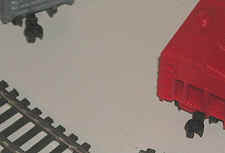Copyright 2003 T. Sheil & A. Sheil All Rights Reserved
All Gauge Model Railroading Page
H.O. as Toy Train
Today, most hobbyists regard H.O. model railroading as a scale hobby. For
the most part, it is. Even today, there are some toy train elements lingering
at the fringes of HO. Many years ago, these elements were far more visible.
H.O. was more often marketed as a toy train than as a scale model.
In the 1950s, scale model railroading was not well-known. It was promoted
mainly by the local hobby shops. HO was seen by most as just another size
of train. Indeed, even experienced train makers approached it in that way.
Lionel made HO as smaller versions of many of its classic cars , including
operating and novelty cars like the helicopter launcher and gold bullion
cars. Gilbert treated it as another size train. Neither fully understood
the nuances that separated scale model railroading from toy train operating.
Marx was a horse of another color. The Louis Marx Company might not have
understood those nuances, but it knew how to sell toys. Marx did well by
providing novel touches to its HO sets, from making them with complete scenery
to producing combined train and slot car sets. Marx's train - especially
the locomotives - were far from being refined scale models. Nonetheless,
Marx sold.
Even experienced scale train makers produced toys. The cheaper train sets
sold to this day are little more than cheap, toy versions of scale models.
Other hobby companies had tried to join the bandwagon by delving into H.O.
Most of their attempts at H.O. fell short of the scale standard.
The result, for scale modelers, is a humorous sideshow of offscale monstrosities,
crude copies and undersized toy trains. The examples shown here are a small
selection of H.O. toy trains.

This is an HO train by Marx, from the 1960s. Here is the 0-4-0 locomotive,
tender and caboose. |

Here's the Marx motor - the spring works like a worm gear that turns a geared
wheel. Notice that the track is hollow, tubular, and joined by little
pins similar to the larger O track. |
 |

Marx's old couplers were solid knuckles. They did not operate, but
they held trains together quite well. |

The gondola and covered hopper from the Marx set. |

Two F units in rather unusual -and probably invented - liveries. The
Army version was made by Cox, a company better known for gas-powered model
airplanes. Between the 1950s and 1970s, more than a few companies tried to
expand into HO trains. |

The Docksider was an obscure locomotive type on the Baltimore & Ohio
railroad. The B&O had all four of them at one time, and later pared
back to two. Because they were popularized for HO in the 1950s by Varney,
however, it is possible to find Docksiders decorated for almost any road
that ever ran steam. Our examples include an IHC version marked for
the Pennsylvania Railroad, and a LifeLike model painted for the Santa Fe. |

you can't see the front couplers, but the Docksiders had them. |

This Hustler / Porter type diesel was made by Marx. Like the Docksider,
Hustlers tend to show up in road names and colors of railroads who never
had them. Even roads that used small "critter" locos never painted
them as brightly as those sold in HO size!
The front coupler is missing on our model. |

Our model has the "NMRA" coupler. We are unsure if it came that way,
or if the original coupler was replaced. |

You can just about see the "made by Marx" under the cab. |
 |
Click here to return to All Gauge Model Railroading
main page











